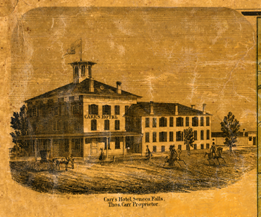Early Seneca County History

Writing, in 1671, of the region which is now Seneca County, Father Raffeix, a Jesuit priest, said: “Goiogouen is the fairest country I have seen in America. It is a tract between two lakes and not exceeding four leagues in width, consisting of almost uninterrupted plains, the woods bordering it are extremely beautiful. Around Goiogouen there are killed more than a thousand deer annually. Fish, salmon, as well as eels and other fish are plentiful. Four leagues from here I saw by the side of a river (Seneca) ten extremely fine salt springs.”
Little more than a hundred years later, the army of General Sullivan penetrated to this same district, and was likewise impressed by the beauties of this region. They found it a favorite home place of the Indians, and the plains covered with quantities of corn, beans, melons; also an abundance of apples, plums and peaches. One of this army was the first to settle in Seneca County.
A traveler passing through here in 1791 remarked that: “The map of the world does not exhibit two lakes equal in magnitude to the Seneca and Cayuga, which are so happily situated. The country between these two lakes rises gradually in symmetry from the opposite shores towards the center, producing a pleasing effect. Whenever it reaches a state of cultivation it will become the ‘Paradise of America.”‘
The narrow strip thirty-five miles from north to south, and ten miles wide, now known as Seneca County, has retained much of its pristine beauty and has certainly reached a “cultivated state.” The plateau has become the seat of hundreds of farmsteads; the shores of the lakes are the favored building sites of lovers of nature; and the great bodies of water contribute an ameliorating influence on the climate that makes not only the region the more habitable, but has made its soil more surely productive.
The Jesuits were the first white men to reach this district with their missions to the aborigines. The lakes and their shores had been divided by two tribes; the Cayugas ranged on both sides of the lake which has been given their name, and the Senecas holding both shores of Lake Seneca. In the period from 1656 to 1684 the Fathers carried on their missionary labors in the Indian towns of the Seneca country. The Moravian missionaries, Bishop Cammerhoff and Rev. David Zeisberger, passed through the territory in 1750, and Rev. Samuel Kirkland tells of going up the Seneca River in 1756. Sullivan, in 1779, came with his troops, and it was but a few years before the great tide of immigration had set in, and the country began to have the cleared lands and homes of the pioneers. Job Smith, the first of the permanent settlers, came from Ulster County, in 1787, and built a log house on the present site of the village of Seneca Falls.
Lawrence Van Cleef, another of Sullivan’s army, located in the same region in 1789 with his family, buying Smith’s hundred acre claim. Romulus, Ovid, Lodi and Waterloo were all settled in 1781, while the other towns of the county were pioneered but a few years later. By 1800 there were nearly 5,000 people in the Seneca District. These early pioneers were of many nationalities, and from many different sections of the colonies. German and Scotch Irish, from Pennsylvania; Holland and Dutch and English, from eastern New York; Yankees, and a few who were directly from foreign lands. It is probably this admixture of so many peoples, minds and interests that resulted in the solid, shrewd, hard-working population which built here their homes and county.
Seneca was, when these first settlements were made, a part of Montgomery County, passing from this to Herkimer, 1791; to Onondaga, in 1794; then in Cayuga, 1799; from which it separated, March 24, 1804, when the laws of its incorporation were signed by Governor Clinton. The name was derived from the lake, river and Indians, who are said to have been the most warlike of the Six Nations of the Iroquois. Perhaps some of this warlike nature was absorbed by the inhabitants of the county, for there had been many difficulties and political fights before any county had been erected; and there were others started when the question arose of where the county seat should be established.
In an effort to prevent this not unusual condition, an act had been passed that the courthouse and jail were “to be erected in the town of Ovid, within certain specified boundaries.” But vigorous protest came from the village of Lancaster (Willard) besides one or two others, and the matter was brought before the Legislature, which only confirmed its order, and a courthouse and jail was started in Ovid, in 1806.
In 1817 the new county of Tompkins was set up with a part of lower Seneca, leaving the county seat within four miles of the southern line, and, although Covert returned to the fold in 1819, Ovid was still too far from the center of the county to be desirable as the county seat, hence Waterloo was named the sole county seat in 1819. The erection of a new county, in 1823, put Waterloo in much the same relation to the rest of Seneca as had been Ovid. A division of county affairs was made and the double shire, or half-half shire system, still in force, came into being.
The original county extended some sixty-three miles north and south and included Ithaca, with an average width of eleven miles, and a total area of 744 square miles. As reduced by the changes and as it now is, the length of Seneca is thirty-two miles, the width ten, area nearly 200,000 acres, with two county seats fifteen miles apart, at Ovid and Waterloo.

